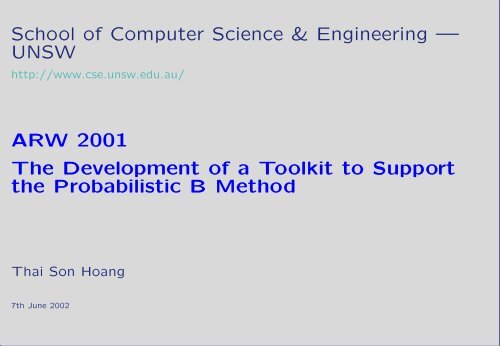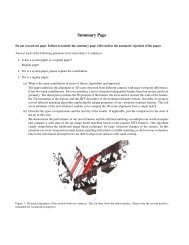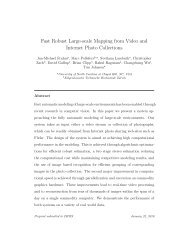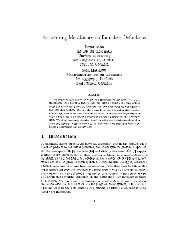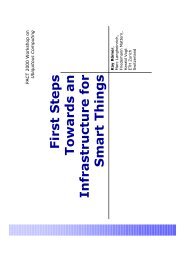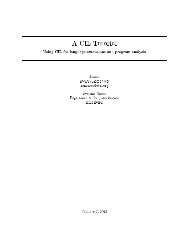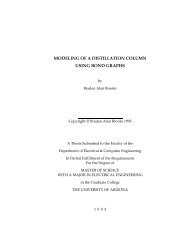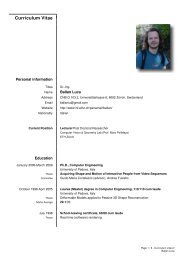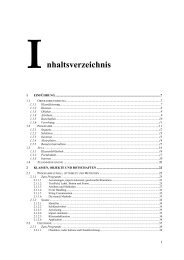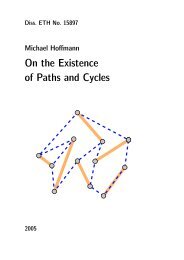slides - Department of Computer Science
slides - Department of Computer Science
slides - Department of Computer Science
You also want an ePaper? Increase the reach of your titles
YUMPU automatically turns print PDFs into web optimized ePapers that Google loves.
School <strong>of</strong> <strong>Computer</strong> <strong>Science</strong> & Engineering —<br />
UNSW<br />
http://www.cse.unsw.edu.au/<br />
ARW 2001<br />
The Development <strong>of</strong> a Toolkit to Support<br />
the Probabilistic B Method<br />
Thai Son Hoang<br />
7th June 2002
Outline
Outline<br />
• A brief introduction to B and GSL.
Outline<br />
• A brief introduction to B and GSL.<br />
• Introduction to pGSL.
Outline<br />
• A brief introduction to B and GSL.<br />
• Introduction to pGSL.<br />
• New pB construct .
Outline<br />
• A brief introduction to B and GSL.<br />
• Introduction to pGSL.<br />
• New pB construct .<br />
• Example <strong>of</strong> probabilistic Number.
Outline<br />
• A brief introduction to B and GSL.<br />
• Introduction to pGSL.<br />
• New pB construct .<br />
• Example <strong>of</strong> probabilistic Number.<br />
• Conversion <strong>of</strong> B-Toolkit.
Outline<br />
• A brief introduction to B and GSL.<br />
• Introduction to pGSL.<br />
• New pB construct .<br />
• Example <strong>of</strong> probabilistic Number.<br />
• Conversion <strong>of</strong> B-Toolkit.<br />
• Conclusion.
Introduction to B and GSL
Introduction to B and GSL<br />
• B-Method is a systematic development <strong>of</strong> large s<strong>of</strong>tware systems from<br />
reusable fragments.
Introduction to B and GSL<br />
• B-Method is a systematic development <strong>of</strong> large s<strong>of</strong>tware systems from<br />
reusable fragments.<br />
• B-Toolkit is built to illustrate all the aspects <strong>of</strong> B-Method.
Introduction to B and GSL (Cont.)<br />
• B-Method based on Generalized Substitution Language (GSL) by<br />
Abrial.
Introduction to B and GSL (Cont.)<br />
• B-Method based on Generalized Substitution Language (GSL) by<br />
Abrial.<br />
– [x := E]R ≡ The predicate obtained after replacing all free occurrence <strong>of</strong> x<br />
in R by E.<br />
– [P | G]R ≡ P&[G]R<br />
– [P =⇒ G] ≡ P ⇒ [G]R<br />
– [skip]R ≡ R<br />
– G‖H ≡ apply the substitutions G and H concurrently.<br />
– [G; H ]R ≡ [G]([H ]R)<br />
– [G[]H ]R ≡ [G]R&[H ]R
Introduction to B and GSL (Cont.)<br />
• The developer write programs (machines) using Abstract Machine Notation<br />
(AMN) into the B-Toolkit.
Introduction to B and GSL (Cont.)<br />
• The developer write programs (machines) using Abstract Machine Notation<br />
(AMN) into the B-Toolkit.<br />
Simple machine written in AMN:<br />
VARIABLES xx, yy
Introduction to B and GSL (Cont.)<br />
• The developer write programs (machines) using Abstract Machine Notation<br />
(AMN) into the B-Toolkit.<br />
Simple machine written in AMN:<br />
VARIABLES xx, yy<br />
INVARIANT xx : NAT & yy : NAT
Introduction to B and GSL (Cont.)<br />
• The developer write programs (machines) using Abstract Machine Notation<br />
(AMN) into the B-Toolkit.<br />
Simple machine written in AMN:<br />
VARIABLES xx, yy<br />
INVARIANT xx : NAT & yy : NAT<br />
INITIALISATION xx, yy := 0, 0
Introduction to B and GSL (Cont.)<br />
• The developer write programs (machines) using Abstract Machine Notation<br />
(AMN) into the B-Toolkit.<br />
Simple machine written in AMN:<br />
VARIABLES xx, yy<br />
INVARIANT xx : NAT & yy : NAT<br />
INITIALISATION xx, yy := 0, 0<br />
OPERATIONS
Introduction to B and GSL (Cont.)<br />
• The developer write programs (machines) using Abstract Machine Notation<br />
(AMN) into the B-Toolkit.<br />
Simple machine written in AMN:<br />
VARIABLES xx, yy<br />
INVARIANT xx : NAT & yy : NAT<br />
INITIALISATION xx, yy := 0, 0<br />
OPERATIONS<br />
Increase =<br />
BEGIN<br />
xx := xx + 1 ‖<br />
yy := yy + 1<br />
test<br />
END<br />
END
Introduction to pGSL
Introduction to pGSL<br />
• pGSL is the extension <strong>of</strong> GSL.
Introduction to pGSL<br />
• pGSL is the extension <strong>of</strong> GSL.<br />
• The differences between GSL and pGSL: is that predicates (functions from<br />
state to Boolean) have been widened to functions from state to number.
Introduction to pGSL<br />
• pGSL is the extension <strong>of</strong> GSL.<br />
• The differences between GSL and pGSL: is that predicates (functions from<br />
state to Boolean) have been widened to functions from state to number.<br />
• For consistency with Boolean logic, false ↦→ 0, true ↦→ 1. In other words, it acts<br />
over ’expectations’ rather than predicates.
Introduction to pGSL<br />
• pGSL is the extension <strong>of</strong> GSL.<br />
• The differences between GSL and pGSL: is that predicates (functions from<br />
state to Boolean) have been widened to functions from state to number.<br />
• For consistency with Boolean logic, false ↦→ 0, true ↦→ 1. In other words, it acts<br />
over ’expectations’ rather than predicates.<br />
• Notationally, we have kept the predicate syntax as much as possiple.
Introduction to pGSL<br />
• pGSL is the extension <strong>of</strong> GSL.<br />
• The differences between GSL and pGSL: is that predicates (functions from<br />
state to Boolean) have been widened to functions from state to number.<br />
• For consistency with Boolean logic, false ↦→ 0, true ↦→ 1. In other words, it acts<br />
over ’expectations’ rather than predicates.<br />
• Notationally, we have kept the predicate syntax as much as possiple.<br />
• Example <strong>of</strong> an expression in pGSL:<br />
(yy + 1 ∈ N ∧ expectation((yy + 1) − 2 × xx)) × frac(1, 2)
New pB construct
New pB construct<br />
• pGSL: Probabilistic choice substitution S p ⊕ T .
New pB construct<br />
• pGSL: Probabilistic choice substitution S p ⊕ T .<br />
• pAMN:<br />
PCHOICE p OF<br />
S<br />
OR<br />
T<br />
END
Example <strong>of</strong> probabilistic Number
Example <strong>of</strong> probabilistic Number<br />
A machine that has two counting devices on it. The machine has one operation<br />
namely Increase. When invoking this operation
Example <strong>of</strong> probabilistic Number<br />
A machine that has two counting devices on it. The machine has one operation<br />
namely Increase. When invoking this operation<br />
• the first device increases its value probabilistically. Half <strong>of</strong> the time, it increases<br />
the value by 1. The other half <strong>of</strong> the time, it keeps the value the same.
Example <strong>of</strong> probabilistic Number<br />
A machine that has two counting devices on it. The machine has one operation<br />
namely Increase. When invoking this operation<br />
• the first device increases its value probabilistically. Half <strong>of</strong> the time, it increases<br />
the value by 1. The other half <strong>of</strong> the time, it keeps the value the same.<br />
• the second device increases its value deterministically by 1.
Example <strong>of</strong> probabilistic Number<br />
A machine that has two counting devices on it. The machine has one operation<br />
namely Increase. When invoking this operation<br />
• the first device increases its value probabilistically. Half <strong>of</strong> the time, it increases<br />
the value by 1. The other half <strong>of</strong> the time, it keeps the value the same.<br />
• the second device increases its value deterministically by 1.<br />
And we expect that the value on the second device is always twice the value on<br />
the first device.
Example <strong>of</strong> probabilistic Number (Cont.)<br />
Using pAMN, below is the Increase operation:<br />
Increase =<br />
BEGIN<br />
PCHOICE 1^/2 OF<br />
xx := xx + 1<br />
OR<br />
skip<br />
END<br />
END ‖<br />
yy := yy + 1
Example <strong>of</strong> probabilistic Number (Cont.)<br />
Specification <strong>of</strong> probabilistic Number is shown below (in pAMN notation).<br />
MACHINE pNumber<br />
SEES Real TYPE, Bool TYPE<br />
VARIABLES xx, yy<br />
INVARIANT<br />
xx : NAT & yy : NAT &<br />
expectation(yy - 2 ∗ xx)<br />
INITIALISATION<br />
xx, yy := 0, 0
OPERATIONS<br />
Increase =<br />
BEGIN<br />
PCHOICE 1^/2 OF<br />
xx := xx + 1<br />
OR<br />
skip<br />
END<br />
yy := yy + 1<br />
END<br />
END<br />
‖
Pro<strong>of</strong> obligations generator
Pro<strong>of</strong> obligations generator<br />
The rules are:<br />
• The initialisation needs to establish the invariant on the assumption <strong>of</strong> the<br />
context <strong>of</strong> the machine.
Pro<strong>of</strong> obligations generator<br />
The rules are:<br />
• The initialisation needs to establish the invariant on the assumption <strong>of</strong> the<br />
context <strong>of</strong> the machine.<br />
• The operations need to maintain the invariant.
Pro<strong>of</strong> obligation for initialisation
Pro<strong>of</strong> obligation for initialisation<br />
Proving by using pB’s rules:<br />
[xx, yy := 0, 0]xx ∈ N ∧ yy ∈ N ∧ expectation(yy − 2 × xx)<br />
≡ 0 ∈ N ∧ 0 ∈ N ∧ expectation(0)
Pro<strong>of</strong> obligation for initialisation<br />
Proving by using pB’s rules:<br />
[xx, yy := 0, 0]xx ∈ N ∧ yy ∈ N ∧ expectation(yy − 2 × xx)<br />
≡ 0 ∈ N ∧ 0 ∈ N ∧ expectation(0)<br />
We need to have precondition in the initialisation.<br />
PRE expectation(0)<br />
THEN<br />
xx, yy := 0, 0<br />
END
Pro<strong>of</strong> obligation for Increase operation
Pro<strong>of</strong> obligation for Increase operation<br />
• Rule for probabilistic choice substitution.<br />
[S p ⊕ T ]R ≡ p × [S]R + (1 − p) × [T ]R
Pro<strong>of</strong> obligation for Increase operation<br />
• Rule for probabilistic choice substitution.<br />
[S p ⊕ T ]R ≡ p × [S]R + (1 − p) × [T ]R<br />
• Arithmetic with Real number.
Modifying the B-Toolkit
Modifying the B-Toolkit<br />
• Internal structure <strong>of</strong> the B-Toolkit
Modifying the B-Toolkit<br />
• Internal structure <strong>of</strong> the B-Toolkit<br />
1. Motif interface.
Modifying the B-Toolkit<br />
• Internal structure <strong>of</strong> the B-Toolkit<br />
1. Motif interface.<br />
2. Theories driven processes.
Modifying the B-Toolkit<br />
• Internal structure <strong>of</strong> the B-Toolkit<br />
1. Motif interface.<br />
2. Theories driven processes.<br />
• What to do<br />
– Analyzer.
Modifying the B-Toolkit<br />
• Internal structure <strong>of</strong> the B-Toolkit<br />
1. Motif interface.<br />
2. Theories driven processes.<br />
• What to do<br />
– Analyzer.<br />
– PO generator.
Modifying the B-Toolkit<br />
• Internal structure <strong>of</strong> the B-Toolkit<br />
1. Motif interface.<br />
2. Theories driven processes.<br />
• What to do<br />
– Analyzer.<br />
– PO generator.<br />
– Prover.
Case studies
Case studies<br />
• Random algorithms.
Case studies<br />
• Random algorithms.<br />
• Uncertainties in Networking
Conclusion
Conclusion<br />
• The introduction <strong>of</strong> pGSL helps the programmers handle probabilistic properties<br />
<strong>of</strong> s<strong>of</strong>tware formally.
Conclusion<br />
• The introduction <strong>of</strong> pGSL helps the programmers handle probabilistic properties<br />
<strong>of</strong> s<strong>of</strong>tware formally.<br />
• The new Toolkit will assist in developing and maintaining s<strong>of</strong>tware with<br />
probabilistic properties.
Conclusion<br />
• The introduction <strong>of</strong> pGSL helps the programmers handle probabilistic properties<br />
<strong>of</strong> s<strong>of</strong>tware formally.<br />
• The new Toolkit will assist in developing and maintaining s<strong>of</strong>tware with<br />
probabilistic properties.<br />
• Further more, in the future, the Toolkit can be upgraded to support other<br />
properties <strong>of</strong> s<strong>of</strong>tware development.


